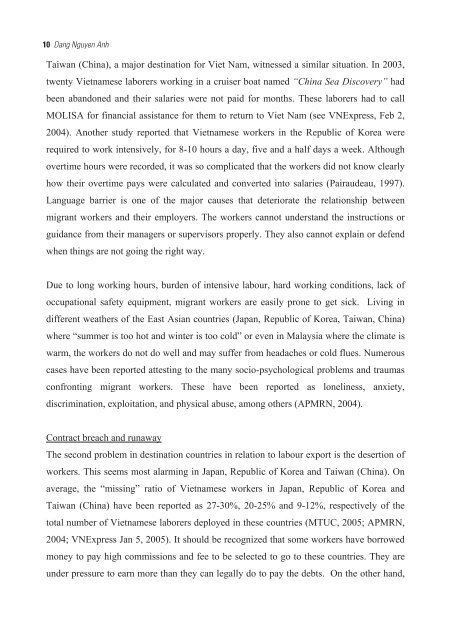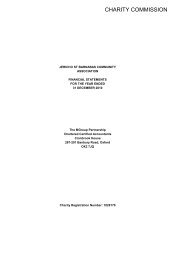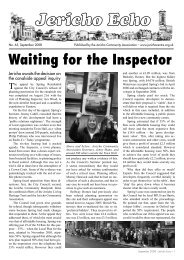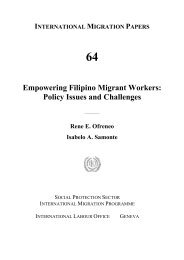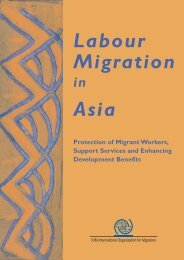Labour migration from Viet Nam: Issues and policy and practice, âpdf ...
Labour migration from Viet Nam: Issues and policy and practice, âpdf ...
Labour migration from Viet Nam: Issues and policy and practice, âpdf ...
Create successful ePaper yourself
Turn your PDF publications into a flip-book with our unique Google optimized e-Paper software.
10 Dang Nguyen Anh<br />
Taiwan (China), a major destination for <strong>Viet</strong> <strong>Nam</strong>, witnessed a similar situation. In 2003,<br />
twenty <strong>Viet</strong>namese laborers working in a cruiser boat named “China Sea Discovery” had<br />
been ab<strong>and</strong>oned <strong>and</strong> their salaries were not paid for months. These laborers had to call<br />
MOLISA for financial assistance for them to return to <strong>Viet</strong> <strong>Nam</strong> (see VNExpress, Feb 2,<br />
2004). Another study reported that <strong>Viet</strong>namese workers in the Republic of Korea were<br />
required to work intensively, for 8-10 hours a day, five <strong>and</strong> a half days a week. Although<br />
overtime hours were recorded, it was so complicated that the workers did not know clearly<br />
how their overtime pays were calculated <strong>and</strong> converted into salaries (Pairaudeau, 1997).<br />
Language barrier is one of the major causes that deteriorate the relationship between<br />
migrant workers <strong>and</strong> their employers. The workers cannot underst<strong>and</strong> the instructions or<br />
guidance <strong>from</strong> their managers or supervisors properly. They also cannot explain or defend<br />
when things are not going the right way.<br />
Due to long working hours, burden of intensive labour, hard working conditions, lack of<br />
occupational safety equipment, migrant workers are easily prone to get sick. Living in<br />
different weathers of the East Asian countries (Japan, Republic of Korea, Taiwan, China)<br />
where “summer is too hot <strong>and</strong> winter is too cold” or even in Malaysia where the climate is<br />
warm, the workers do not do well <strong>and</strong> may suffer <strong>from</strong> headaches or cold flues. Numerous<br />
cases have been reported attesting to the many socio-psychological problems <strong>and</strong> traumas<br />
confronting migrant workers. These have been reported as loneliness, anxiety,<br />
discrimination, exploitation, <strong>and</strong> physical abuse, among others (APMRN, 2004).<br />
Contract breach <strong>and</strong> runaway<br />
The second problem in destination countries in relation to labour export is the desertion of<br />
workers. This seems most alarming in Japan, Republic of Korea <strong>and</strong> Taiwan (China). On<br />
average, the “missing” ratio of <strong>Viet</strong>namese workers in Japan, Republic of Korea <strong>and</strong><br />
Taiwan (China) have been reported as 27-30%, 20-25% <strong>and</strong> 9-12%, respectively of the<br />
total number of <strong>Viet</strong>namese laborers deployed in these countries (MTUC, 2005; APMRN,<br />
2004; VNExpress Jan 5, 2005). It should be recognized that some workers have borrowed<br />
money to pay high commissions <strong>and</strong> fee to be selected to go to these countries. They are<br />
under pressure to earn more than they can legally do to pay the debts. On the other h<strong>and</strong>,


